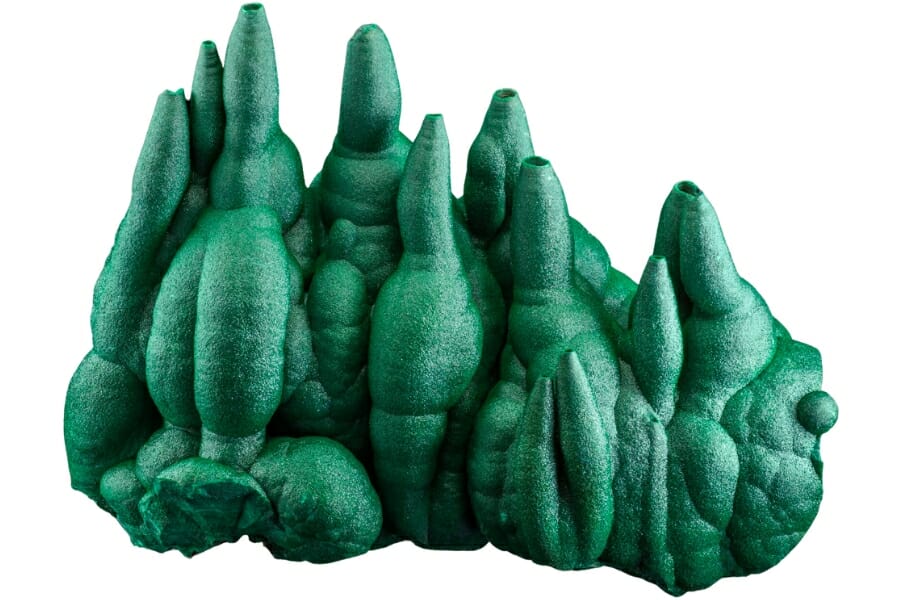Malachite has a rich, vibrant green color that can dazzle anyone who spots it. When sunlight hits it just right, it shines and sparkles, making it a rockhound’s dream.
But when you’re out on a hike and you spot a flash of bright green, how do you know it’s this gem?
In this article, we’re going to be your trusty guide on how to identify malachite and not miss it without knowing. We’ll also point you to some of the best spots for malachite hunting.
The next time you’re out in the field, you won’t miss a piece of malachite, even if it’s trying its best to hide!
What Is Malachite?
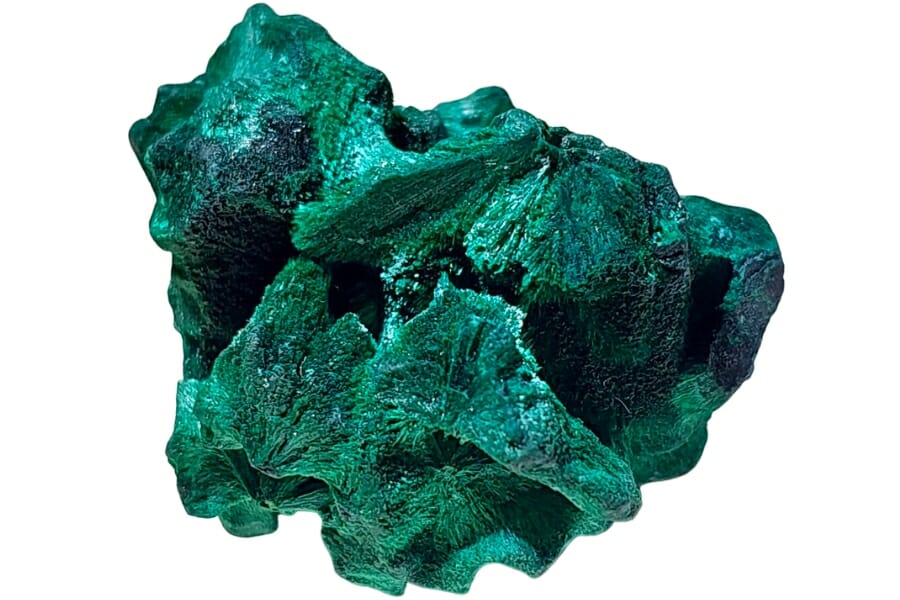
Malachite is a super cool green rock that gets its bright color from copper, which is mixed in with it. Over time, water drips down and reacts with the copper, creating this fantastic green gem.
What’s neat is that malachite has layers of different green shades. It’s like looking at a beautiful green cake.
If you’re wondering where to find it, this beauty loves to hang out in copper mines. Some of the best places to find this rock are in the Democratic Republic of the Congo, Russia’s Ural Mountains, and even parts of Arizona, USA.
The different types of malachite
Malachite has several variations in terms of its appearance and crystal structure. Below are some characteristics and types of malachite based on its formations:
Banded malachite
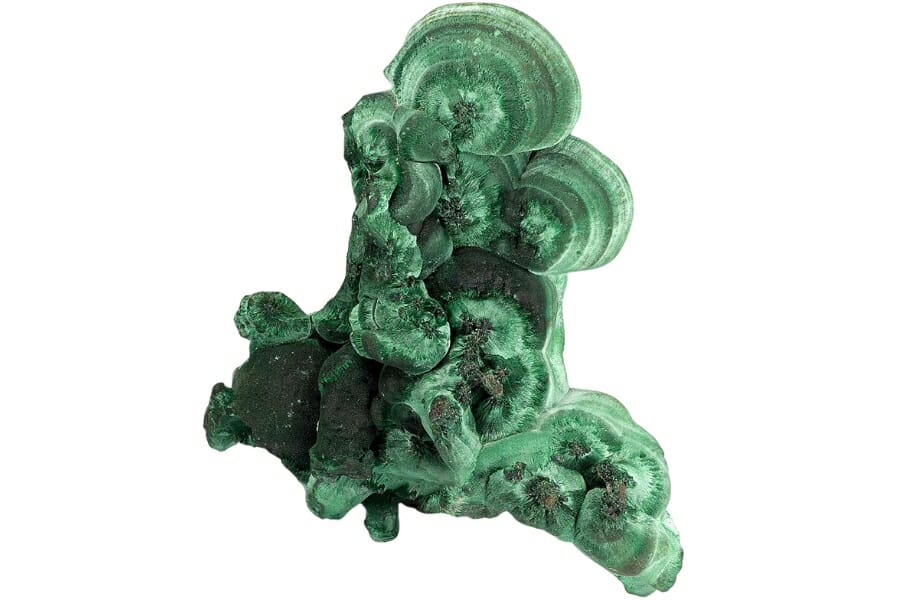
Among all the cool forms of malachite, there’s one that stands out: banded malachite. This type has layers and layers of different green shades, just like a fancy layered cake.
What makes banded malachite special is that those layers aren’t just for show. They can tell scientists and rock lovers how conditions changed when the malachite was forming.
Banded malachite has been popular for thousands of years. Ancient Egyptians used it for jewelry, and even today, it’s a hit for making beautiful decorations.
If you’re hoping to find some of this layered beauty, the best spots are in places with lots of copper. Think of regions like the Democratic Republic of the Congo or the state of Arizona, USA.
Botryoidal malachite

“Botryoidal” means this malachite looks like a bunch of grapes or tiny bubbles all packed together. When you see it, you’ll think Mother Nature had fun making this one!
What sets botryoidal malachite apart from other types is its bumpy, round shapes. It’s a rock that looks like it’s trying to be a cluster of green grapes.
Instead of the usual layers we see in banded malachite, this one grows in cool, rounded formations.
If you want to find this grape-like wonder, look in areas rich in copper, like copper mines.
Fibrous malachite
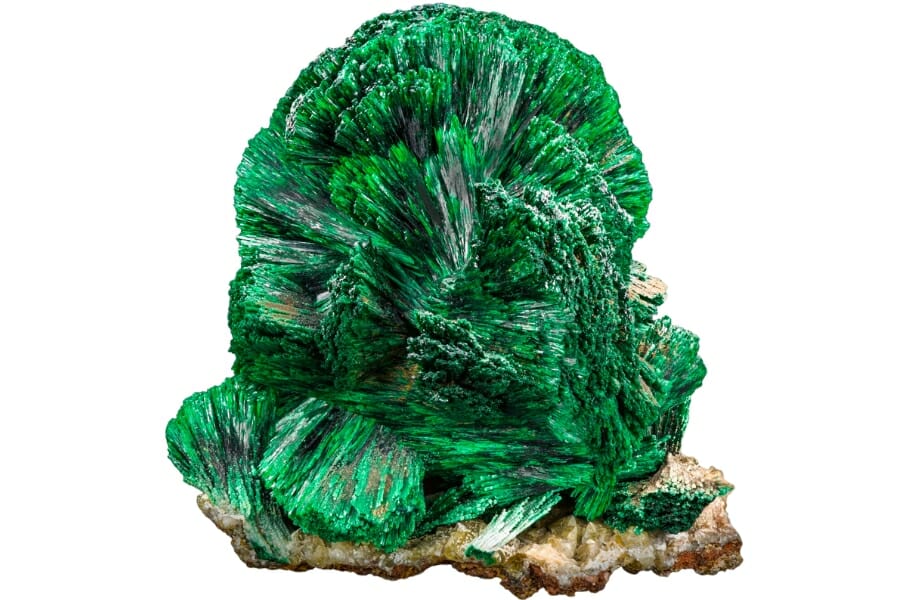
You might be thinking, “Fibrous? Like threads?” And you’d be right on the money. This malachite looks like it’s made of tiny green threads all bunched up together.
Unlike the other types that have bands or bubbles, this one has a silky, thread-like texture. When you touch it, it almost feels like a soft fabric, like the universe spun green silk into a rock.
An interesting bit about this is that fibrous malachite sometimes sparkles. When those tiny fibers catch the light just right, they shimmer and shine.
If you’re itching to find this green wonder, aim for areas where there’s a lot of copper, like where you’ll find other types of malachite.
Stalactitic malachite

Ever seen those pointy rock formations hanging from cave ceilings? Those are stalactites. Now, imagine them in dazzling shades of green. That’s stalactitic malachite.
While other types of this rock grow flat or bubbly, this one dangles and grows in pointy shapes, kind of like icicles. It’s like nature’s own green chandelier.
Some stalactitic malachite can even grow really long, almost like fingers. It’s a super slow process, but over time, these green icicles can get pretty big, and they’re an absolute treat to look at.
Feeling adventurous? To find this hanging beauty, you’ll want to explore copper-rich caves or places where water drips over minerals.
Druzy malachite

Druzy malachite is a rock surface that’s covered in thousands of tiny, glittering crystals of green. When light hits these crystals, they twinkle and shine.
What makes this type of malachite special is, well, its sparkles! While other types have bands, bubbles, or fibers, druzy malachite is studded with countless small crystals.
A fun fact about this is that the word druzy refers to the layer of tiny crystals that form on some minerals. When this happens to malachite, it’s like a green fireworks show.
Look for druzy malachite in places packed with copper. And when you’re searching, remember to let the light be your guide. That sparkle is hard to miss!
Pseudomorph malachite

Pseudomorph might sound like a superhero name, but it actually means “false shape.”
Pseudomorph malachite starts off as one mineral and then transforms into malachite while keeping its original shape. Imagine a rock that was once something else, like azurite, but then changed into malachite.
The cool part? It keeps the shape of the original mineral. This transformation usually happens when water, rich in certain chemicals, flows over the mineral.
Eager to find this shape-shifting wonder? The best treasure spots are in areas loaded with copper. Famous places include the Democratic Republic of the Congo and certain areas in Arizona, USA.
Where To Find Malachite
If you want to learn how to find malachite, you should first know the right places where you should look for it. Below are some of our most recommended sites where malachites love to hide:
Copper Queen Mine, Cochise County, Arizona

Located in Bisbee, Arizona, the Copper Queen Mine is one of the oldest and most famous in the USA. And guess what? It’s a jackpot for finding malachite!
The Copper Queen Mine is unique because it’s packed with copper. And where there’s copper, there’s often malachite.
This place has given rockhunters some of the most beautiful malachite pieces ever found! From bright green bands to those amazing bubbly shapes, this mine has it all.
Now, here’s a fun tidbit: Malachite from the Copper Queen Mine is sometimes found with another blue mineral called azurite.
If you ever find yourself in Arizona, the Copper Queen Mine is a must-visit. Not only will you learn a lot about mining history, but you might also stumble upon some dazzling malachite treasures.
Carrizo Creek, Baca County, Colorado

Nestled in the heart of Colorado’s beautiful landscapes, Carrizo Creek is a fantastic spot to search for the green treasure we all love.
This creek flows through areas rich in copper deposits. And as we know, where there’s copper, there’s a good chance for malachite. Over time, the flowing water interacts with these deposits, creating perfect spots for malachite to form.
Some malachite pieces from Carrizo Creek have unique patterns that look like whirlpools or even green spiderwebs! Every rock tells a story, and the malachite from here definitely has some fascinating tales to share.
If you ever get a chance to explore Colorado, don’t miss out on exploring Carrizo Creek.
Silver Island Mountains, Tooele County, Utah

Silver Island Mountains in Utah aren’t just stunning to look at, they’re also a fantastic place to go hunting for malachite.
This place is special for many reasons, but for rock enthusiasts like us, it’s the copper deposits that make them shine. And as we keep saying, where there’s copper, there’s a chance to find beautiful malachite.
Actually, malachite from the Silver Island Mountains is known for its vivid green color. Some say it’s as if the spirit of the mountains got captured inside the stone.
So, if you’re itching for a malachite hunting adventure in Utah, the Silver Island Mountains should be on your list.
Nacimiento Mountains, Sandoval and Rio Arriba Counties, New Mexico

Nacimiento Mountains in New Mexico are majestic mountains that aren’t just a treat for the eyes, but also a hotspot for those who are searching for malachite.
What’s the magic behind these mountains? Well, they have some nifty copper deposits. And where there’s copper, there’s a golden opportunity (or should I say, a “green” opportunity?) to find malachite.
Malachite from this location often showcases deep, mesmerizing green patterns. Some pieces even look like they’ve captured the landscape of the mountains themselves, with layers resembling the hills and valleys.
If your rockhounding heart is yearning for a journey, the Nacimiento Mountains in New Mexico are calling! Besides the thrill of finding malachite, the sheer beauty of the landscape is enough to make your trip unforgettable.
New Cornelia Mine, Pima County, Arizona

New Cornelia Mine in Arizona is a real hotspot for those on a quest for malachite. Nestled in the desert landscape, this mine is like a treasure chest just waiting to be opened.
Like our other recommended places here, New Cornelia Mine has rich copper deposits, where you have a big chance to discover shimmering malachite. Many have been dazzled by the beautiful green specimens they’ve found here.
Some of the malachite you’ll find here have these amazing swirly patterns, almost like nature’s very own fingerprint.
So, if you’re ever in Arizona with a rockhounding itch, the New Cornelia Mine should definitely be on your radar. Between the rich history of the mine and the promise of malachite treasures, it’s a journey you won’t forget.
How To Identify Malachites Once You Find Them
Let’s say you’re up and ready to explore our recommended hunting sites, do you know how to identify malachite in the field when you see one?
With many other green wonders out there, it’s kind of tricky to successfully distinguish malachite from the rest, unless you know how to spot it from the inside out.
What malachite looks like on the outside
Here are observable traits of malachites on the outside so you don’t walk past one without knowing:
Bright green shades

Malachite has such an eye-catching shade of green that’s hard to miss. It’s almost like the gem is giving us a big, bright, green wink, saying, “Hey, here I am!”
This vivid color is one of this rock’s most defining features. From a rich, forest green to a slightly lighter, almost electric green, malachite stands out like a green beacon among other stones.
If you’re out in the field, this dazzling green is your best clue! In places with lots of different rocks, malachite’s unique green can act like a spotlight.
But remember, not all green stones are malachite. A great tip is to look for that signature brightness. While other minerals might be green, very few have the same bright and vibrant shade as malachite.
Matte finish with a slight sheen

In its natural state, malachite isn’t the shiniest of rocks. Instead, it has a more subtle beauty with a matte finish. That means it’s not super glossy.
But don’t let that fool you! Malachite also has a slight sheen which, when caught in the right light, can look absolutely mesmerizing.
When you’re out exploring and come across a green stone, that finish can be your clue. Many other green minerals might be glossy or shiny, but malachite prefers to keep things cool and understated.
Its surface also often feels smooth and slightly waxy, and if it’s polished, it’s even more velvety to touch.
Often paired with blue azurite

Malachite and azurite are what we can call the dynamic duo of the mineral world. These two are like the best of buddies, often hanging out together. Malachite, with its radiant green, and azurite, with its deep, royal blue, make quite the pair.
If you’re exploring in the field and stumble upon a rock showing both blue and green, it’s like hitting the jackpot. It’s a big hint you’ve got both azurite and malachite.
These minerals often form together, especially near copper deposits, creating a stunning blend of colors.
Keep this in mind during your rockhounding adventures: spotting blue and green together can be like a secret code that you’ll be well on your way to identifying these two amazing minerals.
What malachite looks like on the inside
If you’re wondering about malachite’s characteristics from the inside, here’s what you should be looking out for:
Varied shades of green

Malachite’s green color goes beyond the surface. When you’re out in the field, this vibrant hue can be your guiding star.
Malachite boasts a spectrum of greens, from deep forest shades to bright, almost electric greens. If you’re out rockhounding and you spot a stone with these fabulous green bands or layers, there’s a good chance you’re onto some malachite.
It’s unique because not many minerals have such a wide range of green in just one piece. The deeper and more vivid the green, the higher the copper content in that malachite.
Radiating crystal formation

When you peek inside malachite, you often see these awesome, radiating crystal formations.
Imagine a fireworks display but in shades of green! These patterns look like little green spokes or starbursts all coming out from a single point.
When you’re out in the field, these crystal patterns can be your special clue! Not many rocks have this unique crystal growth, especially in such vibrant green colors.
If you crack open a stone and notice these spokes or star-like patterns inside, give yourself a high-five because you might’ve just found a malachite.
Velvety texture
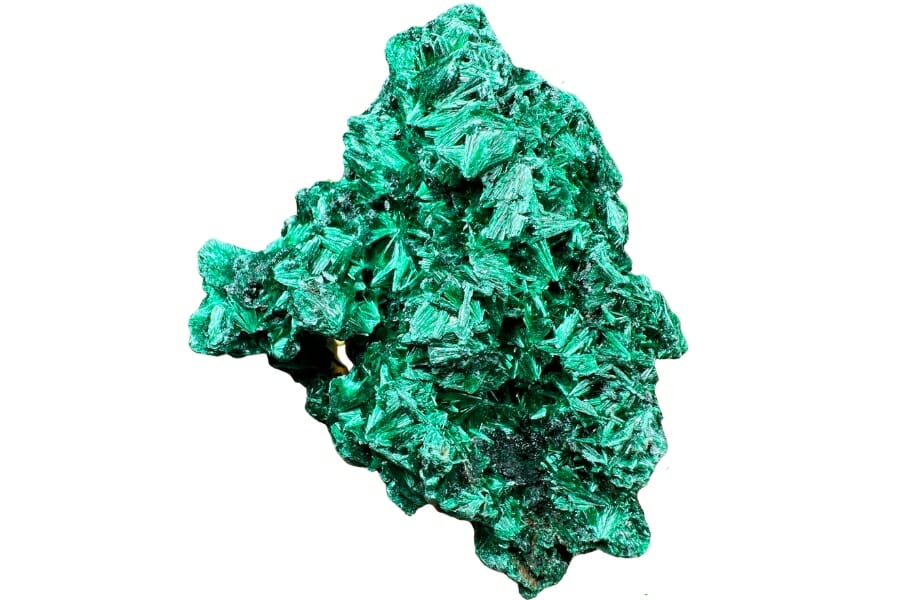
When you get a close look at malachite, especially when it’s broken or cut open, it can have this super cool, almost soft-looking texture. It’s like someone took the softest green velvet curtain and turned it into a rock.
This velvety look is all thanks to malachite’s fibrous crystal growth. It forms in these fine, parallel lines that give it that soft, brushed appearance.
If you’re out in the wild to search for this gem, this is a big hint! If you stumble across a rock with this velvet-like texture in shades of green, chances are, you’re holding malachite.
Not many minerals have this unique inside look. So, use that velvet vibe as your green light (pun intended!) to identify some awesome malachite.
How To Find Malachite
To help you increase your chances of finding malachite, here are some tips and tricks that you can do:
Look for green streaks
One of the best ways to spot malachite when you’re out and about is to look for amazing green streaks.
Imagine you’re out in the wild, scanning the ground for cool rocks, and suddenly you spot a flash of bright green. That’s a clue telling you that malachite might be nearby.
This vibrant green color is like malachite’s signature. It stands out from other rocks and minerals, making it a bit easier to find. These green streaks or patches are formed as malachite fills in cracks and crevices in host rocks.
Keep your eye out for blue finds
Yes, that’s right! Spotting blue can also lead you to the green treasure of malachite. Azurite, a beautiful mineral, is often found right next to malachite.
Azurite is bright blue, and it’s just as eye-catching as malachite’s signature green. When you’re out exploring, if you see a hint of this deep blue color, there’s a good chance malachite might be nearby too.
Both minerals often form together because they share a similar origin, coming from the oxidation of copper ores.
The next time you’re on a rock-hunting adventure, don’t just look for green. Keep an eye out for that striking blue too.
Examine weathered rocks
When you’re out searching for malachite, take a closer look at those weathered rocks. Malachite loves to form in areas where rocks have been affected by weathering.
Weathered rocks have been beaten by the elements— rain, wind, heat, and cold. Over time, this breaks down other minerals and creates spaces for new ones to form, like malachite.
These rocks might have cracks, hollows, or other interesting patterns on them, and these are the perfect spots where malachite can grow.
If you find a rock that looks like it has seen its fair share of storms, take a closer look because there might be beautiful green streaks or spots of malachite hiding there.

